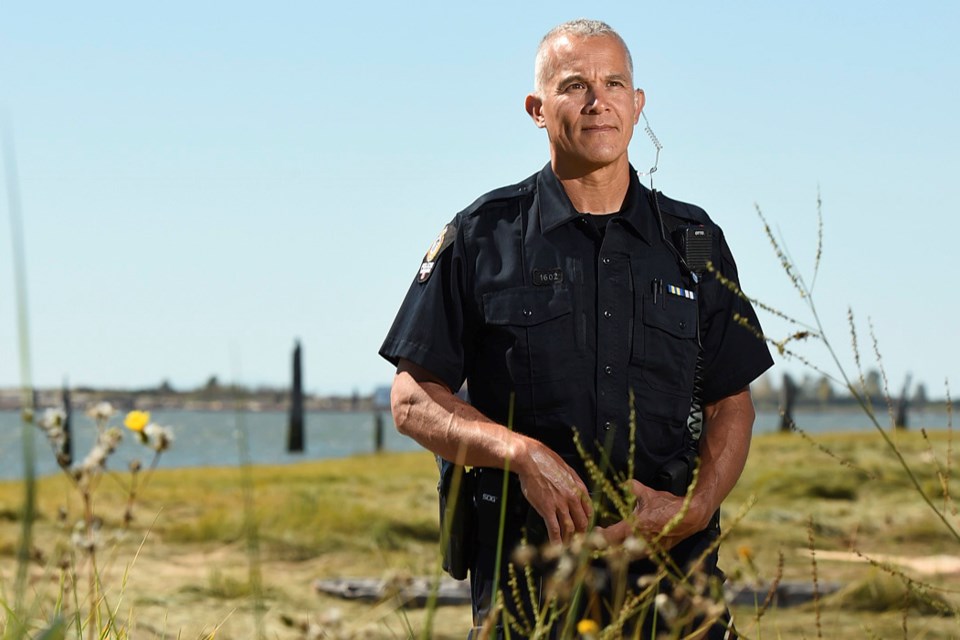Frank Joseph Paul.
It’s a name known to many people in this city because of what happened to the 48-year-old man sometime between Dec. 5 and 6, 1998 in an East Side alley.
Paul died of hypothermia after a Vancouver police officer driving a prison wagon chose to leave the chronic alcoholic in an alley near East Second Avenue and Scotia Street rather than admit him to the neighbourhood’s detox centre.
Earlier that night, Paul was turned away from jail.
A man searching for a lost cat at 2 a.m. found Paul’s body in the alley and called 911. Paul’s death set off years of criticism against the Vancouver Police Department, triggered various investigations and led to an inquiry that concluded officers failed to provide a proper level of care for Paul that cold winter night.
The VPD apologized to Paul’s family and acknowledged in a report to the Vancouver Police Board that the man’s death raised “perceptions of racism, indifference and cultural insensitivity towards the Aboriginal community.”
Paul was a member of the Mi’kmaq First Nation in New Brunswick. His death only inflamed years of mistrust that Aboriginal people already had with police.
That mistrust was exacerbated when women began going missing from the Downtown Eastside. Many of the women were Aboriginal and later found murdered. Police eventually captured Robert Pickton in 2002, ending a killing spree that made the Port Coquitlam pig farmer Canada’s worst serial killer.
Police Chief Adam Palmer is obviously familiar with the cases, having begun his career in 1987. His predecessors have had to answer for the tragedies and attempt to repair a damaged relationship with the Aboriginal community.
Palmer now has to answer for the department’s current relationship, which he described as “very good.” In fact, he said from his office at the Cambie Street police precinct, it’s getting better all the time.
“It’s a lot better than when I came on the job back in 1987,” he said. “Back then, I was a young patrol officer. My frame of reference was that I didn’t know what the [VPD] executive was doing, but my general sense of it was there wasn’t a lot of community outreach like there is now.”
Palmer went on to list a number of programs and initiatives the VPD has implemented in the past decade to improve relations with Aboriginal residents.
The list includes cultural sensitivity training last year for hundreds of his officers, a committee comprised largely of Aboriginal women to combat violence in the Downtown Eastside, an Aboriginal policing centre and two cadet programs.
The VPD also has 24 Aboriginal officers, some of whom work directly with young Aboriginal people, the fastest growing demographic in Canada.
Palmer pointed to the benefits of the renewed relationship with the Aboriginal community, singling out the Sisterwatch program in the Downtown Eastside, where women and police work together to prevent predators from stalking vulnerable residents.
That partnership led to the arrest of Martin Tremblay, whom members of Sisterwatch believed was preying on young Aboriginal girls. Police targeted Tremblay, a convicted sex offender, and he was sent to jail.
“In the past, I’m not convinced that we had those relationships in place where people would have come forward like that,” said Palmer, who continues his predecessor Jim Chu’s “lunch with the chief” meetings at the Carnegie Centre, where officers dine with residents of the Downtown Eastside. “It’s one of the most rewarding events I go to.”
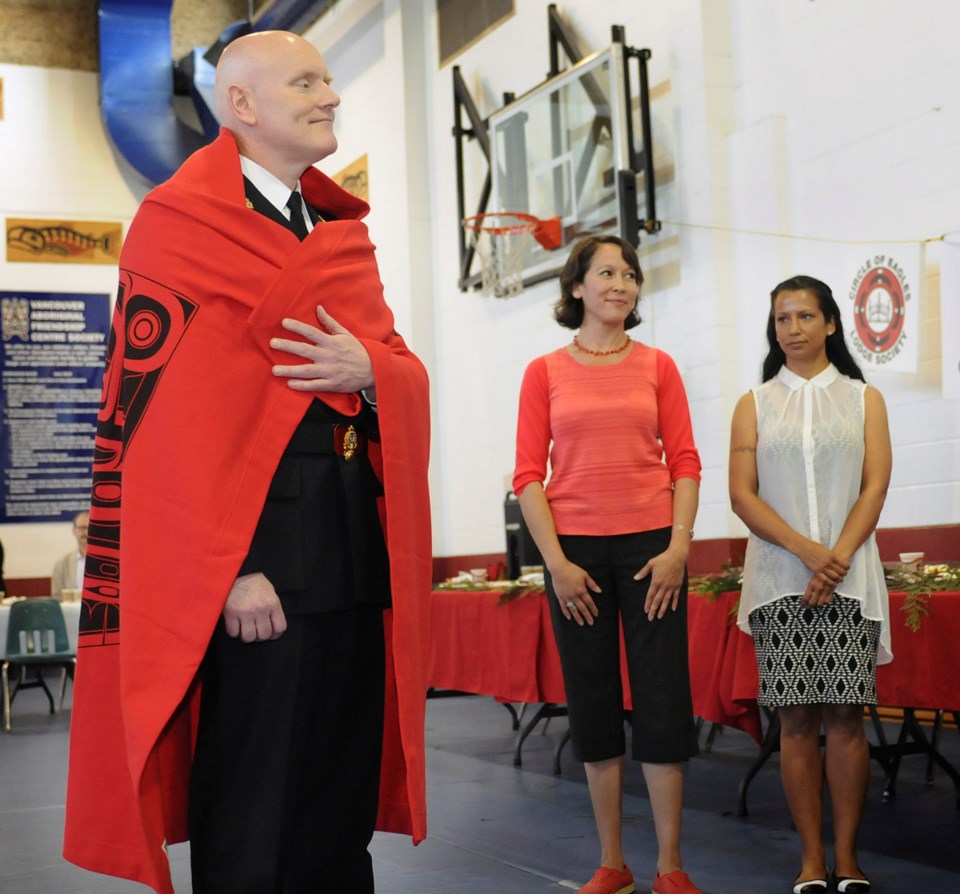
Palmer has since participated in a sweat lodge with members of Sisterwatch. And last year, Aboriginal leaders welcomed him as the department’s new chief in a ceremony at the Aboriginal Friendship Centre.
He keeps the red and black Coast Salish blanket he was given that day on a shelf in his office. He got shivers up his spine when it was draped on him, he said, the same shivers that come when the VPD’s pipe band strikes up.
As Palmer has laid it out, the direction of the VPD sounds progressive and promising, and a long way from the animosity that existed between police and the Aboriginal community following the death of Frank Paul.
Still, there are questions from Aboriginal residents and others. Is the VPD’s commitment authentic? Are all cops following Palmer’s lead? And will relationships improve where they matter most — on the street?
These are questions the Courier put to Aboriginal leaders, a legal society that represents Aboriginal clients and a former VPD cop who is now the province’s deputy police complaint commissioner. Mayor Gregor Robertson also weighed in, as did Const. Steve Hanuse, an Aboriginal VPD officer who now tells his own story to recruits and serving officers to better educate them about an indigenous population that continues to grow.
‘Respect the history’
For years, Hanuse kept his story to himself.
In fact, when he joined the VPD 26 years ago, his superiors asked him about doing outreach in the Aboriginal community.
He told them he didn’t have a lot to offer.
But he knew he did, and only recently has he and other Aboriginal VPD officers opened up about what life was like for them before joining the department.
“I can’t tell you how proud I am to take part in that and make sure that members who are 25 years on the job, 10 years on or six months on, know about this and respect that, and respect the history.”
The “this” and “that” is colonialism and the residential school system. It’s also the uniform, a symbol of power, of government and intimidation.
“The uniform is someone who came in and took the children away from communities,” said Hanuse, a member of the Namgis First Nation from Alert Bay.
Hanuse, 50, grew up in Burnaby. That’s where his mother fled to escape the abuse she experienced in her community. Hanuse never knew his father and has three sisters and two brothers from four different men.
At an early age, he became like a parent to his family and would often have to track down his mother, who was battling alcoholism; she has since been sober for many years.
“I used to know the phone numbers of the Balmoral and Sunrise hotels off by heart,” he said of the notorious Downtown Eastside single-room-occupancy hotels, where his mother would drink. He said he was 10 or 11 years old when he made the calls. “I didn’t have to look them up. We didn’t have Google back then. But those were the numbers I phoned to see if my mom was coming home, and if I had to get my brothers and sisters ready for school in the morning.”
School was also a struggle and a place where he tried to keep his heritage a secret. He dreaded his first days in a new classroom, where teachers would often ask students to introduce themselves and reveal their backgrounds.
“I remember being in the middle of the room and my heart would be beating so fast because now my secret would be out — that I would have to tell everyone that I’m Aboriginal, and all those negative connotations will rain down upon me because that’s just the way it was in those times.”
Hanuse is referring to the 1970s, where he faced racism in the schoolyard, on the bus, in the streets. By negative connotations, he means “the lazy Indian, the drunken Indian, the dirty Indian.”
“All of those stereotypes were wrong and erroneous, but in my case, they weren’t because I lived in an alcoholic family, so it was tough for me.”
Shades of blue
The responsibility he accepted as a young boy and meeting positive role models in his teenage years inspired him to break free of that cycle of dysfunction and poverty. He put his energy into sports, where he excelled at soccer and then decided he wanted to be a cop.
A friend from Douglas College, who is now an inspector in the VPD, convinced him it was the right decision. Hanuse said his friend, Steve Eely, had only been on the job for about a year and told him how fulfilling the work was.
It was a big step for Hanuse, whose perception as a young boy of police was “by and large, us and them.” He said he never grew up with a positive image of police, although he pointed out he never had any run-ins with officers.
“I saw a lot of violence in my own family and trouble with the law with an older brother. So that was the image that I saw. It’s hard to explain but it just wasn’t positive at all.”
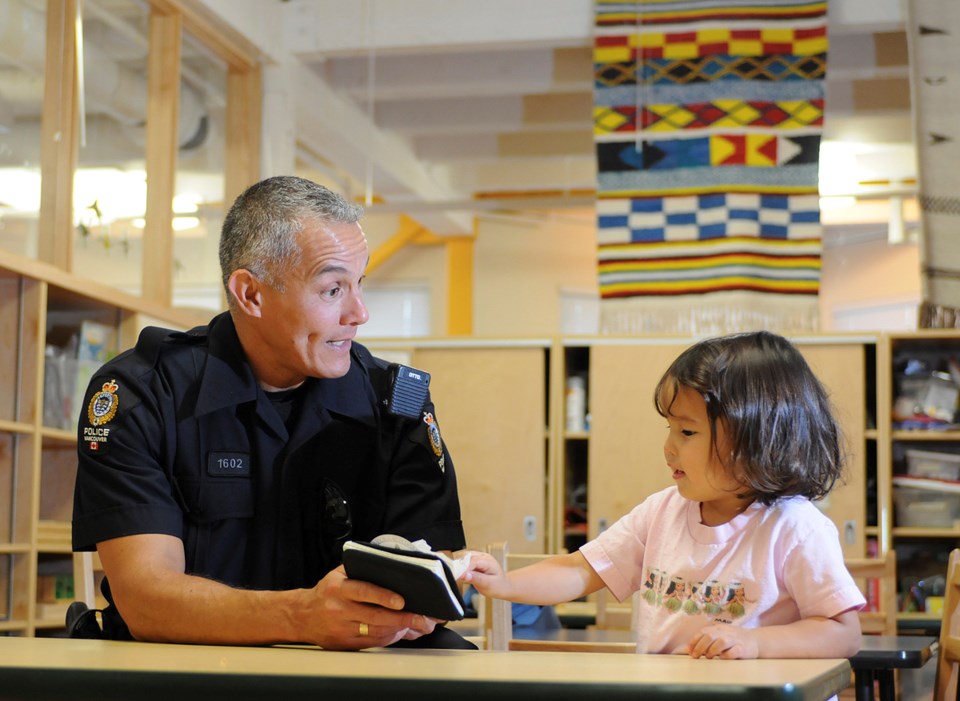
When he joined the VPD, many family members were working through issues with drugs and alcohol and making better lives for themselves. They never questioned his decision and are proud of Hanuse, who said it is well known in Alert Bay what he does for a living.
So that’s why it was hard for him, he said, when the VPD was accused of racism in the death of Frank Paul. He recalls attending a public forum after Paul’s death and having to speak out on behalf of officers.
“I remember distinctly standing up and saying what’s so hard for me is the stereotypes and the racism that I felt as a young Aboriginal growing up in the ’70s is exactly what I was feeling at that moment,” he said. “I said I work with a number of very dedicated and hard-working officers that are not racist, that are not doing these things and that you’re painting us all with the same brush. I sat down and I was close to tears.”
He pointed out police knew Paul very well, having taken him into custody more than a dozen times in the months leading up to his death. The B.C. Ambulance Service responded to 121 calls for Paul over two years before he died.
For the past five years, Hanuse has been the VPD’s liaison officer to the Musqueam Indian Band, where Chief Wayne Sparrow said he’s fit in well and “we kind of consider him a Musqueam now.”
“He’s not from the community but he knows the issues and he knows the individuals,” said Sparrow, who noted his cousin Desiree Sparrow is a VPD officer. “It helps on reserve because [an Aboriginal officer] can relate a little bit more. The more that we can deal with some of the social issues that happen in our community and have First Nations people that can completely understand from that side, it can only help.”
More outreach to do
Lawyer Douglas King, who is Pivot Legal Society’s police accountability campaigner, wants to see more Aboriginal officers for the very reason Sparrow expressed: Having officers with a deep understanding of the issues facing indigenous people avoids immediate pushback from a community ingrained to dismiss police.
The fact, he said, the department has 24 Aboriginal officers in a force of 1,300 is evidence the VPD has more outreach to do. (The VPD also has two Aboriginal community safety officers). But King acknowledges the general mistrust of police built up over decades across the country is a hurdle for recruiters.
“It’s a cultural animosity that carries through to this day and that it’s just not socially acceptable for most Aboriginal people to take that as a career because of the level of that historic violence that has taken place between police forces and Aboriginal communities,” he said.
King is worried about the number of Aboriginal clients who complain to him about being injured by police when taken to jail. He has no statistics to quantify the extent of the allegations but plans to file Freedom of Information and Privacy Act requests to get a clearer picture of what he believes is a pattern.
King said his clients are going to jail for intoxication, breach of the peace or causing a disturbance. He pointed out the inquiry into the death of Frank Paul recommended a civilian-operated sobering centre, which still hasn’t been built but would provide a more acceptable alternative than jail.
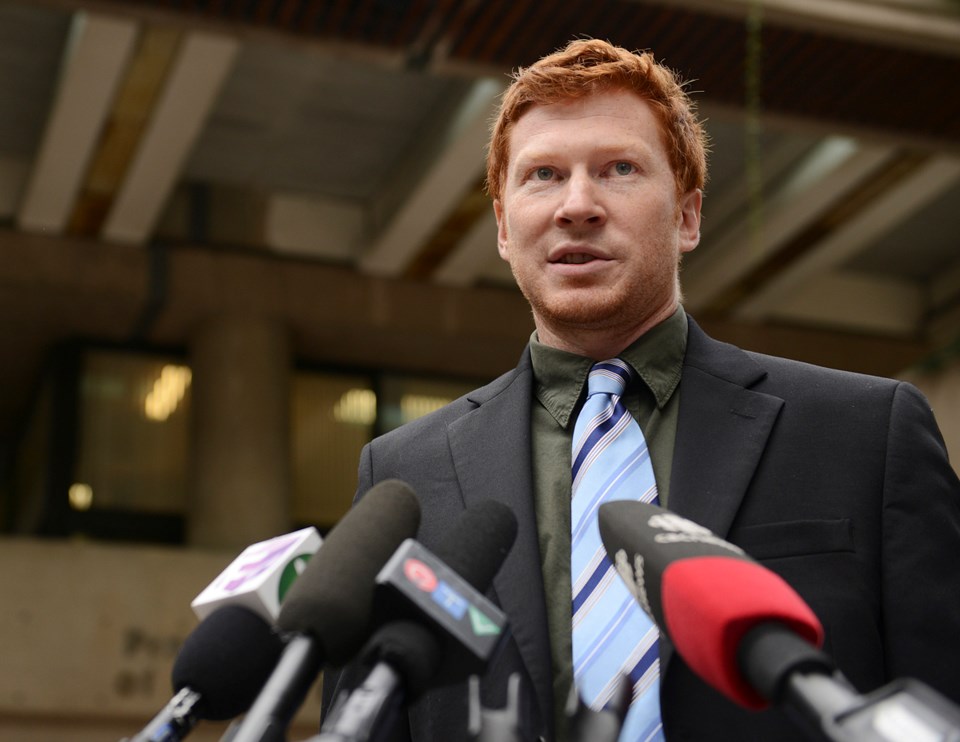
Gavin Wilson, director of public affairs for Vancouver Coastal Health, told the Courier in an email the health authority continues to work on plans and a location for a centre.
King acknowledged the VPD has made some gains in the Aboriginal community with programs and initiatives, as outlined by the police chief, who is a regular at Aboriginal Day festivities and the Missing Women Memorial March.
“But at the end of the day, you can go to all the fairs, you can go to all the community meetings and you can talk about this and that, but it’s how people on the street interact with police is what matters most,” King said.
Building a relationship
Mona Woodward is co-chairperson of the Sisterwatch committee and a support worker for RainCity Housing. In June, she participated in a sweat lodge on the Squamish homelands on the North Shore with Palmer and a few other police officers.
How did that go? “I had mixed emotions,” she replied. Why?
“I don’t know, it was kind of weird. As an Aboriginal woman, you don’t really trust police and you fear them. But in a professional field, I have to put all fears and everything aside to look at the greater picture of working with people in the larger community and try to build those relationships.”
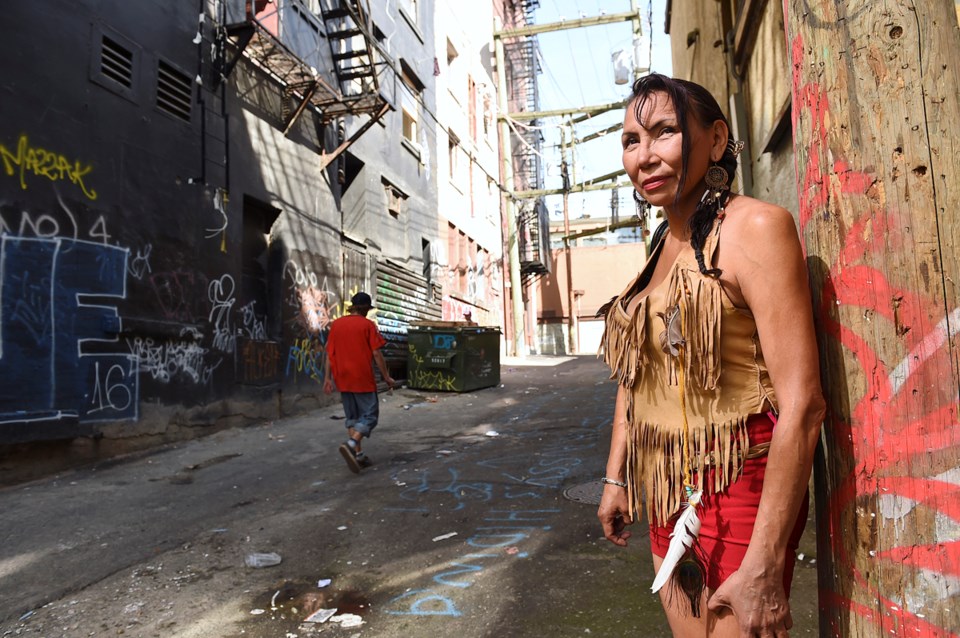
She nor Palmer offered detail of what was said in the lodge, which was constructed from branches and tarps. Inside was a pit in which seven hot rocks symbolizing grandfathers were placed. The men were shirtless and wore shorts. The women were dressed in T-shirts and long dresses. The only light came from the glow of the rocks.
“I wouldn’t consider myself a really religious guy but it’s a spiritual experience,” Palmer said.
“It almost makes you feel closer to the earth, closer to the people that you’re around, and you start thinking about a lot of things in your own life and your relationships. It’s pretty powerful.”
Woodward said her mistrust of police comes from growing up in Regina, “the most racist place in Canada where police beat your ass. You don’t call the cops there. They do what they want.”
Her assessment of Palmer: “Street people can tell in three seconds whether to trust somebody or not and the overall consensus is that he really cares and that he’s genuine.”
That said, she knows Palmer’s leadership skills are best assessed on how his commitment to the Aboriginal community plays out on the streets with the department’s beat cops.
“There’s still misuse of power with residents in the Downtown Eastside,” said Woodward, citing a recent example where a friend was shoved by a cop during a demonstration. “There’s going to be those good cops and there’s going to be those bad cops not working with the proper theory and practice of the department.”
Woodward is one of the reasons the VPD created a Sisterwatch committee with Downtown Eastside women. It was Woodward and women from the community who occupied the then-police headquarters at 312 Main St. in 2010.
It was a stunt to pressure the VPD to investigate what Woodward and other women believed to be the murder of her niece, 22-year-old Ashley Machiskinic, who fell to her death Sept. 15, 2010 from a room at the back of the Regent Hotel.
Jim Chu, who was police chief at the time, called a town hall meeting, which led to the creation of Sisterwatch. It’s an initiative Woodward takes comfort in, knowing her niece didn’t die in vain and “that from her death something beautiful happened.”
Investigators, meanwhile, continue to keep the file open and have drawn no conclusions on how Machiskinic died, although the B.C. Coroners service has said her death wasn’t suspicious.
Sensitivity training
Jerry Adams has been a long-time leader in Vancouver’s Aboriginal community. He’s also a former member of the Vancouver Police Board and current executive director of Circle of Eagles transition house for Aboriginal men leaving prison.
The VPD has relied upon Adams to be one of the people to educate officers about First Nations history and provide a window into a past that can help police better understand an Aboriginal person’s state of mind.
He is buoyed by initiatives such as Sisterwatch and the VPD executive’s commitment to train officers. For the most part, he said, officers he’s trained were sensitive to the colonial history and residential school legacy.
“They’re making an effort, but it’s going to take time and I don’t think it’s going to happen overnight,” he said. “There’s still a lot of hurt and pain in our people and with good reason. They haven’t let that go and there are going to be people who are not happy, and we have to respect that.”
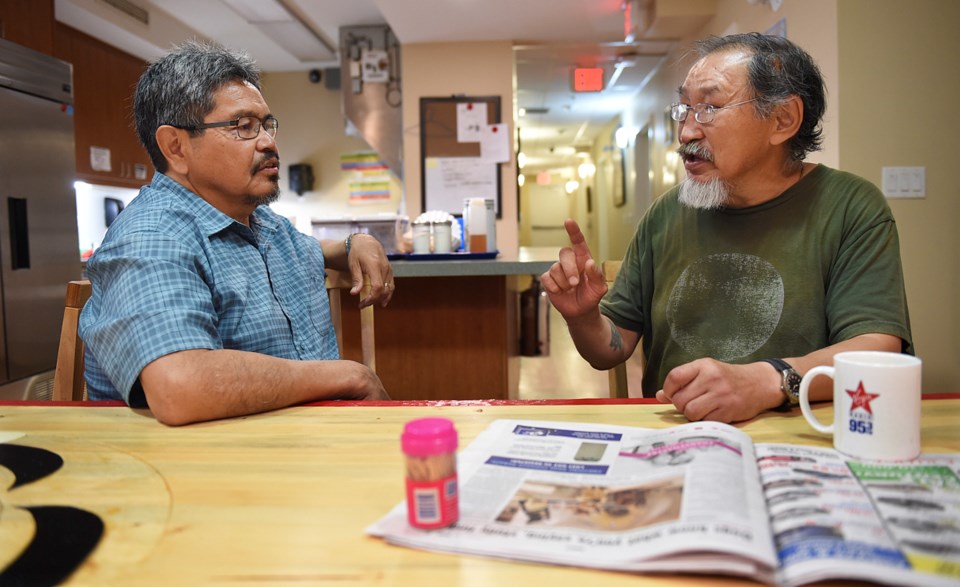
One officer who didn’t get the training ended up being the subject of a recent complaint from an Aboriginal man, whose medicine bag was rifled through and placed upon a police car in the rain.
A medicine bag is considered sacred and tradition states the objects in the bag should only be handled by its owner, or an Aboriginal elder. The man said in his written complaint that he felt police disrespected him and First Nations culture.
The incident dates back to September 2015, when police pulled over the man for driving a pickup truck with a licence plate from another vehicle.
The VPD acknowledged the man’s complaint highlighted a gap in how police handle religious and cultural items. Now an officer must request the owner to open the pouch and manipulate the objects for visual inspection, if it is safe to do so.
That safety provision extends to a prisoner being able to wear the bag while in custody. The policy stated all examinations of a medicine bag should be done by a male officer.
“Many Aboriginal cultures prescribe that women are far more spiritually powerful than men, and even simply viewing the contents of a bag will alter their efficacy,” the policy report said.
Cultural shift
Rollie Woods, B.C.’s deputy police complaint commissioner and a former VPD and RCMP officer, said he was impressed by the department’s decision to create a policy for the handling of medicine bags.
The fact the department and the police board agreed to extend that policy to include religious and cultural items related to Jewish, Sikh and Muslim faiths was unexpected, Woods said.
“That’s the kind of response we like to see from a police board and a police department,” he said by telephone from his Victoria office.
Like Palmer, Woods has seen a shift in the VPD’s efforts to reach out to the Aboriginal community. He’s noticed that trend across the country, where police recognize the importance of working with First Nations instead of against them.
“Whether it’s perfect or not, I’m sure people would say it’s not yet,” Woods said. “Vancouver is a doing a good job in many ways, and trying hard. I think they’re well intentioned. The problem with policing, in general, is you’re trying to shift the whole culture and it’s hard to do because there are many people who have been there already 25 or 30 years and they’re resistant to change.”
Added Woods: “So you just have to have strong leaders in place who are going to do the right thing and force the culture to shift. We’re seeing that at the VPD. Since I joined there in 1986, it’s a completely different place than it was back then. It’s a much more progressive department.”
That progression has seen police go on canoe trips with young Aboriginals, set up sports camps and cadet programs. That wasn’t happening when Woods was a young officer.
“Police didn’t see it as their issue, and maybe it wasn’t. But they definitely see it as their issue now. And I think that anywhere there is First Nations people — which is pretty much everywhere — the RCMP and municipal police are trying hard to work with them. You do see an improvement in that relationship, not only with police but with government and society at large.”
Still, Aboriginal people are overrepresented in incarceration rates, as pointed out in a report in January by Correctional Investigator of Canada Howard Sapers, the country’s prison ombudsman. More than a quarter of inmates — 3,723 — in Canadian prisons are of Aboriginal ancestry.
Never, Woods said, does he recall Vancouver consciously targeting Aboriginal people or anyone for that matter solely because of their race. It was never mentioned or discussed when he was with the department.
“Certainly, there was lots of talk about trying to improve relationships after the Frank Paul case and other things like that,” he said, noting race-based complaints lodged against police are rare in B.C. “But nothing has come to our attention in the Aboriginal community that would suggest that there’s some systemic problem with the way the police are dealing with them.”
‘A different world’
In June of this year, Mayor Gregor Robertson and members of the police board chose to hold their monthly meeting at the Musqueam Cultural Centre on the band’s reserve in southwest Vancouver.
Robertson, who doubles as chairperson of the board, sat next to Palmer and listened as Aboriginal officers talked about the work they were doing at Musqueam and across the city.
He heard from Insp. Marcie Flamand, who is Metis and talked about how a former member of VPD’s aboriginal cadet program, Desiree Craig, is now a VPD officer.
He heard from Const. Rick Lavallee, who is Cree and talked about organizing cultural sensitivity training for 500 officers, civilians and community volunteers.
And he heard from Hanuse, who talked about “sharing some tears” with recruits as he told his story about his childhood and the intergenerational effects of the residential school system.
The mayor said during a break in the meeting that he liked what he heard and was seeing as the city continues to aim to be a better place for Aboriginal people.
“The sensitivity is much more real,” Robertson said. “We’re in a different world now from the days of Frank Paul and missing and murdered women. At city hall, we’re focused on living up to our commitment to be a city of reconciliation and that includes all functions of the city, including policing. It doesn’t happen overnight and there are going to be curves in the road, but I’d say we’ve come a long way since the turbulent days of a decade ago.”
Next week: education.
mhowell@vancourier.com
@Howellings
